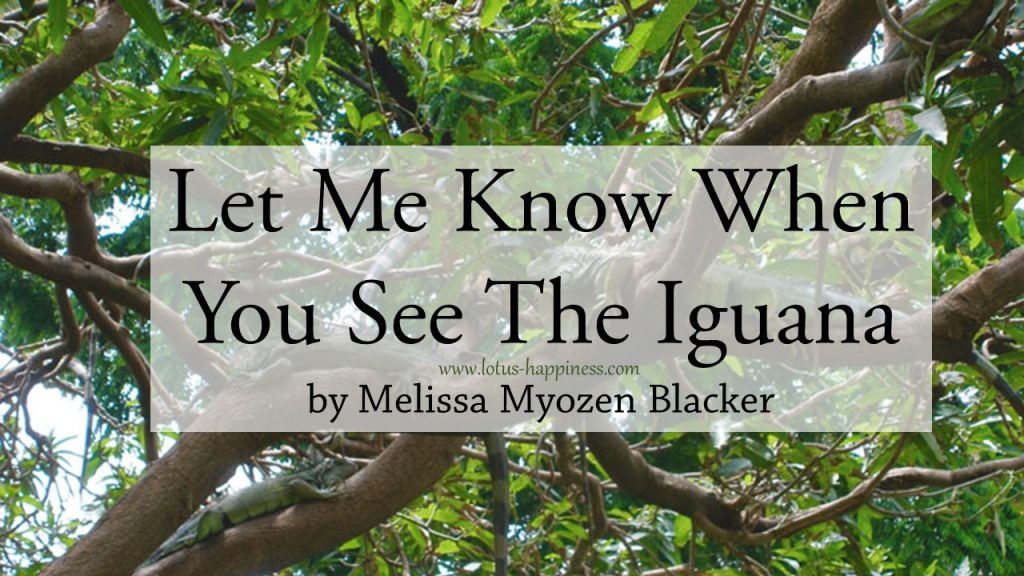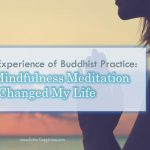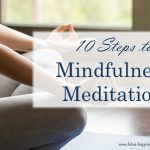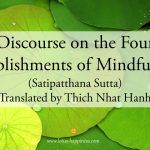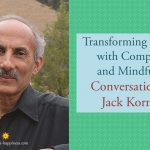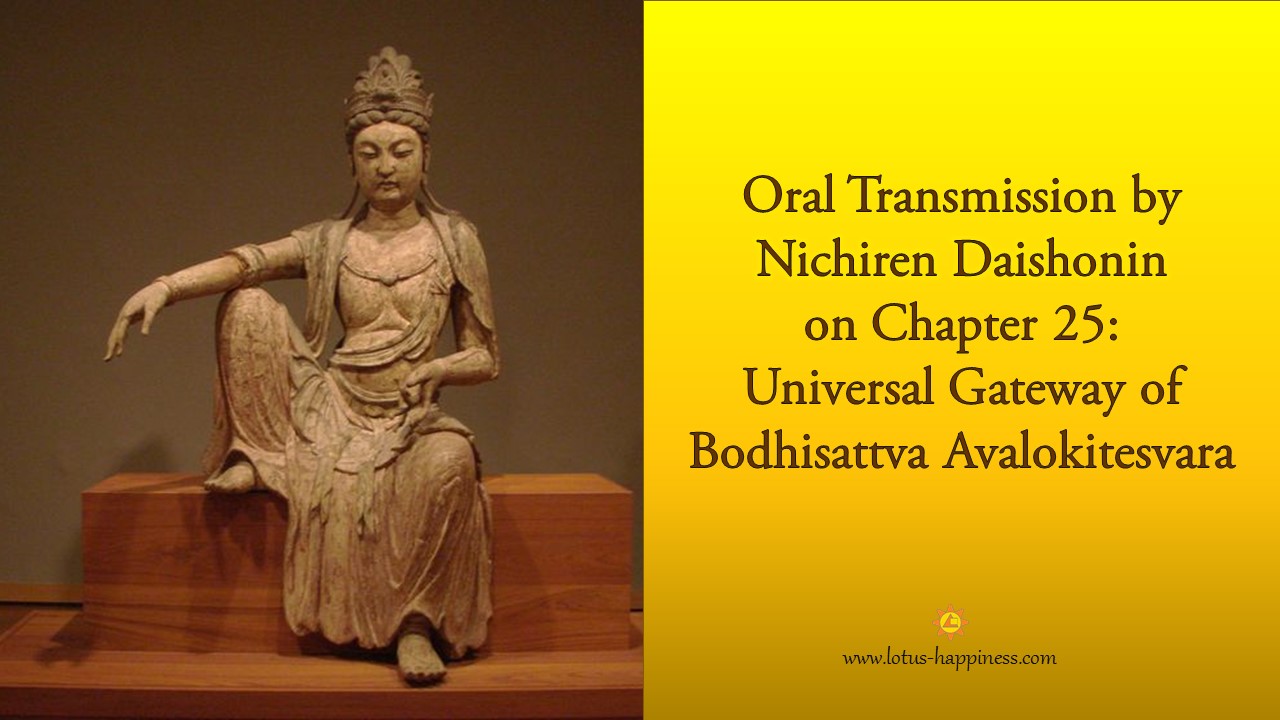Let Me Know When You See the Iguana
Melissa Myozen Blacker proposes that awakening isn’t that complicated. It’s when we encounter something just as it is, without preconception.
You know the feeling: you’ve lost something and suddenly you realize it’s been there right in front of you the whole time. Those missing keys or that misplaced hat were, as they say, hiding in plain sight. They seemed to be invisible and unrecoverable, yet suddenly, there they are. It’s clear to you they were never lost at all.
Once I was on a riverboat tour in the Costa Rican rain forest when our guide suddenly stopped the boat. He asked everyone to sit still, breathe quietly, and let our eyes rest on the tree that was right in front of us. The guide had won our trust with his competence and good humor, so everyone in the boat obeyed him.
He said to us, “Let me know when you see the iguana.”
It was clear to me and every other tourist on the boat that there was no iguana in that tree. It was just a tree, with a brown trunk and green leaves. Sitting still, breathing, looking, I appreciated the tree very much. It was a beautiful tree, in a lovely place. The water lapped at the boat, and I felt very peaceful. After all, he had just given us meditation instructions, and I love to meditate. But there was no iguana in that tree.
And then there was! All over the boat, people started exclaiming, “I see it! I see it!” It had always been there, but before we saw it, we didn’t know we were seeing it.
The practice of waking up in every moment is a bit like spotting iguanas. After every meditation practice, I recite the four bodhisattva vows, a Zen chant that contains the line: “Dharma gates are boundless; I vow to enter them.” This vow reminds me to wake up to the teachings that are offered by the world every moment. Even when I can’t see the iguana, I vow to keep looking for it.
Naturally, a few questions may occur to you concerning this vow. First of all, what are these dharma gates? If they’re so boundless, does that mean that they are everywhere? If that’s true, why don’t I see them? And what’s all this talk about entering them?
When Zen people like me tell stories about the Buddha, we say that this revered and somewhat legendary historical personage was someone just like us. He was searching for meaning in his life and trying everything he could to find the answers to his questions. But after going through many kinds of trainings and getting really good at them all, he still hadn’t found any answers that satisfied him. So he gave up trying. He made his own vow to sit still, just like the tourists in the riverboat, until the true nature of reality revealed itself to him.
After sitting still for some time, he happened to look up at the sky before dawn, just as the morning star appeared. At that moment, he “woke up” to a new understanding of reality and the meaning of human life. He saw that little shining planet without anything getting in the way—just pure seeing. He couldn’t contain his joy, and said, “How marvelous! I, the great earth, and all beings are naturally and simultaneously awakened.”
In that moment, he recognized that what he had been searching for had been right there in front of him all the time. Everything was and always had been naturally awake. And he realized he wasn’t alone in this discovery—he felt completely connected to everything and everyone, and all beings joined him in this great opening to the vivid aliveness that appears everywhere.
After this experience, friends and strangers he met felt that there was something special about him. They asked him if he was a god. He replied, “No, I’m just awake.” In the language he spoke, a version of Pali, the word for one who is awake was “Buddha.”
In Zen we say that everyone is already a buddha, an awakened one. But we don’t know we are until we are shaken out of our complacent habitual thoughts and see clearly that everything we encounter, including ourselves, has the same awakened nature.
Once this truth has been revealed to us, we can no longer avoid it, although we try. Our thought patterns are so firmly entrenched in the neural connections in our brains that our insight is repeatedly overcome by the filters that hide the truth of reality from us. But then, through practice, we set up the conditions for awakening again, and the true world reveals itself.
This reality is one of the ways we translate the word “dharma”—the teachings that were realized by the Buddha through his personal discovery of the way things are.
 In February 2005, artists Christo and Jeanne-Claude installed 7,503 saffron gates along 23 miles of walkways in Central Park, inspired by traditional Japanese torii gates. Photo via julianoassociates.blogspot.ca.
In February 2005, artists Christo and Jeanne-Claude installed 7,503 saffron gates along 23 miles of walkways in Central Park, inspired by traditional Japanese torii gates. Photo via julianoassociates.blogspot.ca.The entry points to the Buddha’s dharma—these “dharma gates”—are everywhere. They are revealed to us when we encounter the world through the heart-mind that has been clarified by the practice of sitting still.
For the Buddha, the dharma gate was the morning star. For the riverboat travelers, it was the iguana. For other people, it could be a flower, or the sound of a bird, or stubbing a toe. It doesn’t have to be a particularly beautiful thing, because it can be anything. By seeing or hearing or tasting or smelling or feeling something without any filters or disguises, whatever we encounter reveals itself, and we wake up.
Because dharma gates are boundless, we don’t have to go somewhere else to find them. They appear everywhere, and our only responsibility is to enter them. Once we begin to recognize this, everything we perceive externally, as well as our own internal experiences of thoughts, emotions, and sensations, become vehicles for awakening to the ultimate truth of reality.
What allows us to enter these gates to awakening are the same instructions that the Buddha, and the riverboat guide, gave: Be still, be quiet, and pay attention. This practice sets up the conditions for revelation. What you have been longing for reveals itself, and you know that it has been there the whole time.
This practice is simple, but it’s so easy to get distracted by all the busyness of our lives and of our minds. Stopping and being still doesn’t always seem possible.
So we might decide that it’s a good idea to go somewhere and sit still with a bunch of other people. Silent, teacher-led meditation retreats are available in many places these days, and if you have ever attended one, you already know how powerful and challenging they can be. And you know how they can contribute to your own realization of the brilliant offerings of the world.
But there is a problem with attending retreats. It’s what happens when you leave. You may have had some kind of revelatory experience in the atmosphere of the silence and support of the other retreatants and teachers. You may even feel that you have been changed forever. But then you leave the retreat, and encounter all those people who haven’t been quiet and still, who have been going about their regular lives. In the face of traffic, crowds, and noise, you may begin to romanticize your retreat experience and wish you could go back to that quiet, peaceful space.
In Zen practice, we say that meditation retreats are one of the most effective ways to set up the conditions for waking up. But we also teach that it is possible to wake up in every moment. Because, after all, dharma gates are boundless.
Opportunities for awakening are everywhere. They are not limited to retreat centers, monasteries, and temples. The to-do list on the fridge and the challenging situations at work are dharma gates, too. The anger in traffic, the argument with a loved one, the sadness, the longing—all of these are dharma gates. Practice in daily life is a more intense form of retreat practice, and endlessly rewarding.
The first requirement for recognizing the boundless entry points to awakening is learning how to stop. Reminders to stop are everywhere, in the form of those lovely red octagonal signs that government workers place at intersections: STOP!
Stopping Practice: Stop, Tune In, Open, Proceed
For twenty years, I taught Mindfulness-Based Stress Reduction at the Center for Mindfulness at the University of Massachusetts Medical School. One of the simplest tools we offered people who wanted to live more mindfully was the word STOP itself. Practicing with STOP allows us to have a tiny little mini-retreat right here, right now. Many people use stopping practice to help reduce stress and tension. The relief of stress can be a wonderful side effect of learning to recognize our awakened nature.
For me, the power of stopping practice lies in its simplicity and adaptability to every situation. The first part of stopping practice is “S”: learning to actually stop. Whatever you are doing, thinking, or saying, alone or with others, you can always pause. You can stop for a moment, or for a longer period of time.
Stopping is powerful, especially if you are busy and hassled. You can practice pausing throughout the day, turning it into a new habit. Maybe you can set a bell to ring on your computer, or put a little sticker on your phone that says, “STOP!” If you’re with other people, you can say, “Can we just take a little pause before we continue?” Or, “I just need a moment.”
The next part, the “T,” stands for “take a breath,“ “take a moment,” or “tune in.” We breathe, pause, and remember we have a body, not just a busy mind. We directly and intimately encounter whatever is here, without judging it or needing it to be different.
When the Buddha sat down and vowed to be still and quiet, his awakening revealed some universal truths to him. He realized that the main obstacle to seeing clearly is our wish for things to be different, our desire to fight reality. If things are good, we want the good times to go on forever. If things are bad, we want them to change into something good. When we stop and tune in, we can clearly recognize our longing for things to change or to stay the same. We realize that when we try to fight reality, we always lose.
Once we have stopped and tuned in, we are ready for “O.” We can “open” to everything: first to our own sense perceptions, thoughts, and emotions, and then to the whole wide environment in which we find ourselves. This is the moment when we see the morning star, when we discover the iguana in the tree. In this opening, clarity arises in our thoughts as well. We may turn the “O” into “Oh! How wonderful!” Or, it can be “Oh! How awful!” The important part of opening is not whether we like or dislike what is happening, but that we are seeing what is happening clearly.
Finally, there is “P.” After the opening, after the clarity and spaciousness of our widened view, we know what to do. We “proceed” if that’s what seems to be the wisest course. We take action.
Meditation practice is not only about sitting around and being quiet and still. It is about seeing clearly how to be effective participants in the world. Instead of adding to the suffering and pain we find everywhere, we can contribute to healing and reconciliation. Of course, because being a human being involves taking chances, when we make a decision to do or say something, we may discover that we are wrong. Our clarity and wisdom may be missing a few important pieces of information, and we may receive feedback directly or indirectly that we have made things worse.
At that point, we can start all over. The “P” could also stand for “pull over and park.” Maybe it’s time to turn off the computer, take a nap, have a snack, or call a dear friend.
Throughout the day, we can practice STOP in an endless cycle of pausing, acting, and learning. Even if we are at an actual silent retreat, the habit of stopping is still necessary, because the mind doesn’t come to a rest simply because the body does.
So, here’s the challenge. Are you ready to taste the truth of what life has to offer? Will you be a bodhisattva, a “wisdom being,” and take the vow to enter every experience, every dharma gate? The road ahead is clearly marked, and you can stop at the very next intersection. I can’t tell you what you’ll encounter, but I suspect it will no longer be any of your old ideas of things. You will discover life itself, vividly appearing to you. And you will know for yourself, like the Buddha, that you, and I, the great earth, stars, iguanas, stubbed toes, and all beings, are naturally and simultaneously awakened.
Source: Lion’s Roar

